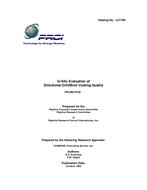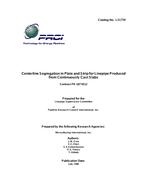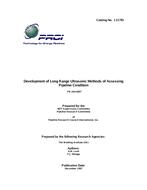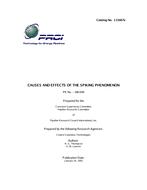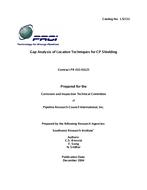Provide PDF Format
PRCI PR-262-9738
- In-Situ Evaluation of Directional Drill/Bore Coating Quality
- Report / Survey by Pipeline Research Council International, 10/01/1998
- Publisher: PRCI
$148.00$295.00
L51799e
CORRENG Consulting Service, Inc.
Need: CORRENG Consulting Service Inc. was retained by PRCI to evaluate known electrical or electrochemical techniques that could potentially be used to assess the coating quality on a directionally bored or drilled pipe. The intent of this research was to recommend and test one or more of the techniques that could be conducted in the field by a pipeline corrosion technician without extensive training using instrumentation to which he/she might normally have access due to the nature of his/her work. The feasibility of using the technique(s) both before and after the directionally bored section is tied into the major pipeline was to be assessed.
Benefit: The objectives of this project were to: (1) examine known techniques of evaluating coating quality on buried pipe; (2) select one or more of these methods for in-situ testing; (3) develop a field test procedure that a corrosion technician can follow using equipment typically at his or her disposal; and (4) evaluate the feasibility of using this procedure both before and after the bored pipe is tied in. Two methods - coating conductance and current requirements - were tested on epoxy-coated pipe samples which were back filled with soil having a different resistivities. Both test methods proved successful; therefore, a field test procedure was developed that incorporates both. However, this procedure cannot be used when the pipe is tied-in because of accuracy limitations of existing current measurement instruments (unless the pipe is tied-in using isolating fittings).
Result: A high degree of agreement was found between the conductance calculated using the general method and the bare area presented by bare steel strips simulating coating damage when the data was plotted on a log-log format. Correlation values were generally greater than 0.9. There were minor effects caused by coupon positioning between top and bottom as well as between the middle and end of each pipe sample. The anomaly produced by the top coupons was attributed to the fact that fewer current paths are available at the top because of the close proximity of ground level. This is not expected to be a problem in the field since the depth of cover on bored piping would normally be much greater than the pipe in this test arrangement.
CORRENG Consulting Service, Inc.
Need: CORRENG Consulting Service Inc. was retained by PRCI to evaluate known electrical or electrochemical techniques that could potentially be used to assess the coating quality on a directionally bored or drilled pipe. The intent of this research was to recommend and test one or more of the techniques that could be conducted in the field by a pipeline corrosion technician without extensive training using instrumentation to which he/she might normally have access due to the nature of his/her work. The feasibility of using the technique(s) both before and after the directionally bored section is tied into the major pipeline was to be assessed.
Benefit: The objectives of this project were to: (1) examine known techniques of evaluating coating quality on buried pipe; (2) select one or more of these methods for in-situ testing; (3) develop a field test procedure that a corrosion technician can follow using equipment typically at his or her disposal; and (4) evaluate the feasibility of using this procedure both before and after the bored pipe is tied in. Two methods - coating conductance and current requirements - were tested on epoxy-coated pipe samples which were back filled with soil having a different resistivities. Both test methods proved successful; therefore, a field test procedure was developed that incorporates both. However, this procedure cannot be used when the pipe is tied-in because of accuracy limitations of existing current measurement instruments (unless the pipe is tied-in using isolating fittings).
Result: A high degree of agreement was found between the conductance calculated using the general method and the bare area presented by bare steel strips simulating coating damage when the data was plotted on a log-log format. Correlation values were generally greater than 0.9. There were minor effects caused by coupon positioning between top and bottom as well as between the middle and end of each pipe sample. The anomaly produced by the top coupons was attributed to the fact that fewer current paths are available at the top because of the close proximity of ground level. This is not expected to be a problem in the field since the depth of cover on bored piping would normally be much greater than the pipe in this test arrangement.
Related Products
PRCI PR-187-9212
Centerline Segregation in Plate and Strip for Linepipe Produced from Continuously Cast Slabs..
$198.00 $395.00
PRCI PR-164-9207
Development of Long Range Ultrasonic Methods of Assessing Pipeline Condition (Phase 4)..
$198.00 $395.00

